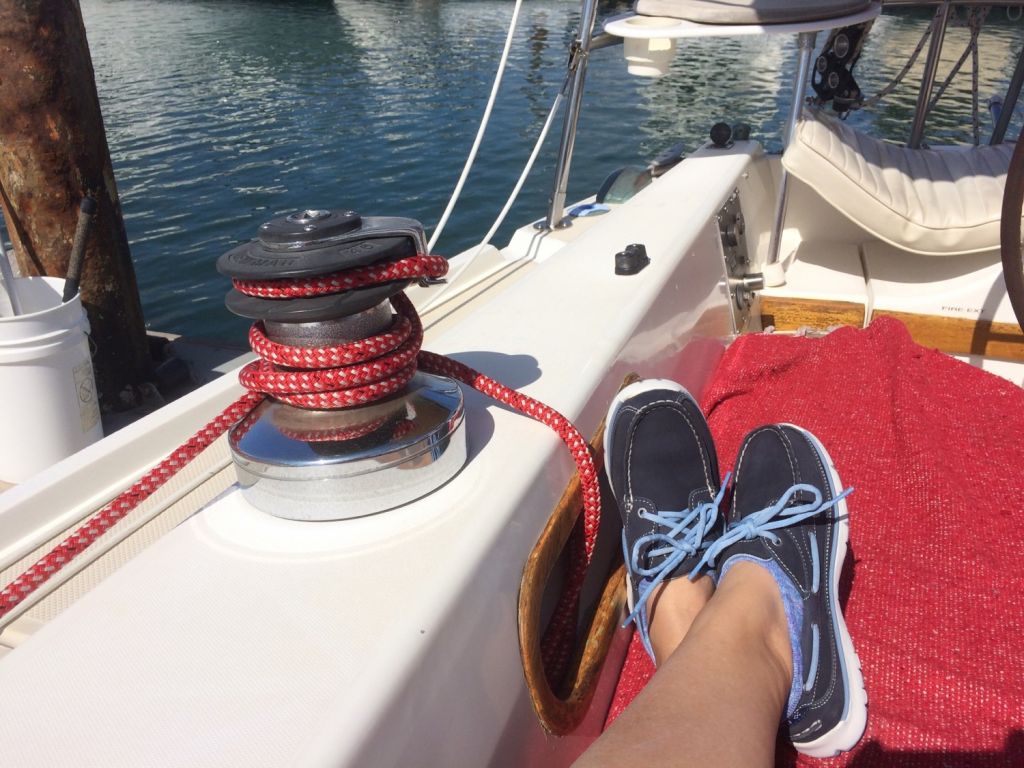
What Shoes Should I Wear for Sailing?
If you’re invited to a friend’s sailboat, you should consider what shoes you bring to the party. Maybe the captain already gave you fair warning that they don’t want you showing up with leather soles or those skid-mark-producing baseball shoes. So what should you wear?
- Deck shoes with non-marking rubber soles
- Plastic sneakers with non-marking rubber soles – light colors will likely skid less
- High-quality water shoes
- Dinghy or sailing boots
- Barefoot & flip-flops are popular but not recommended
As you can see, there are some high-end expensive options you only want to purchase if you plan on sailing often. There are, however, also a couple of good alternatives you probably have laying around the house.
General tips for sailing footwear
At its heart you want three things from your shoes:
- You want a good grip on-deck
- You don’t want to leave marks on the deck
- You want to protect your feet from water, cold, and injury
I’ll explain these tips more in-depth later on, but I want to take a look at the specific shoes first. So let’s dive into the different options in detail below.
Die-hard sailors: deck shoes
As with anything, you will probably have to compromise. In many situations, deck shoes with special rubber soles are your best bet. What’s special about their soles is that they don’t leave marks on the deck. However, not a lot of non-sailing people have these laying around – and if you do, they’re probably those fashionable ones with leather soles.
If you have to buy them for a one-off trip, it’s quite costly. These shoes cost anywhere between $60 – $150. Unless you’re planning on sailing regularly, that’s quite an investment for a day on the water. Luckily, there are some home-and-garden options you probably have lying around.
Lie-around no-slip, non-marking, feet-protecting alternatives
So what could you wear for your one-time trip? Well, if it’s hot outside, I recommend wearing no shoes at all. It’s the easy way out. However, if you’re a novice, you need to be very aware that you don’t have any protection. You will probably stub your toe or something, and it will hurt like hell. But people have actually reported broken toes, cuts from the webbing, and so on.
Anyway, it will only work for slow day trip sailing, with predictable winds and good weather. With racing and sailing high-speed, most captains won’t permit you aboard without shoes. So it’s not recommended
If you do need protection (ie. from the cold), I recommend grabbing some plastic sneakers with a light color sole. Black soles won’t always leave marks, but they mostly will. Your safest bet is white light-colored soles. Most sneakers are also quite comfortable and are mostly designed with sports in mind. So some sneakers will provide a good grip. Please try this out beforehand, because some popular sneaker soles are very slippery when on a wet deck. They also dry quickly, as opposed to leather shoes. The thinner the material, the more quickly it will dry.
Another good one-time alternative is canvas shoes since they’ll dry out quickly. Canvas shoes aren’t a great long-term solution. Neither are sneakers by the way. Canvas shoes are very prone to wear and tear. The sun alone will probably beat them up pretty badly (UV wears down canvas real quick). Also, your All-Star-type laces are a pain to take off once they’re wet. Just so you know.
Other good options
One of the best tips for warm-water sailors are high-quality water shoes, like these ALEADER adventure shoes on Amazon (click to check the current price). I haven’t used them myself since I haven’t done any long-term passages that required some real footwear – instead, I just take off my shoes when it gets warm. But I have heard from other sailors that these are great, and for the price, you could even consider it for your odd trip now and then.
If you want to keep things simple in warm weather, most sailors default to flip flops or sandals (with rubber soles).
Dinghy sailing
I mention this one separately since you want to take a different approach for this type of sailing. In dinghy sailing, your feet WILL get wet. You will take on water, and you might capsize as well. You want a good protecting shoe that dries out very quickly and provides grip as well. Most dinghy sailors go for a special dinghy boot. If you want to see what these look like, check out these Gill competition boots on Amazon (click to check current price). These are high-quality, classic sailing boots.
What You Want from Good Sailing Shoes
Good grip
Sailboats can get pretty choppy from time to time. Having soles that provide good grip is essential. Especially for beginners, this will help you to … well, not fall overboard. The deck can will very slippery when wet. So having soles with some sort of grip pattern is definitely a must.
No marks, no dirt
Why is it important to leave no marks on-board? Well, most decks are very hard to clean. Some fiberglass decks use grip paint, giving them a rough grid, making cleaning rubber skids especially difficult.
A deck is somewhat of a living room: you want to keep it clean and good-looking. Leaving marks is considered a major sailing sin.
Protection
It can get quite cold on the water. Also, the deck hardware, deck grip paint, and altogether pointy bits on a sailboat can really hurt your foot if you’re unlucky.
What Not To Wear
If anything, try to stay away from the proven problematic shoes. So what should you absolutely avoid?
- any metal will corrode – so avoid zippers and so on
- for longer trips, don’t wear canvas
- avoid high heels
- avoid leather soles
- barefoot or flip-flops
High Heels
This might seem super obvious, but well, if it wasn’t for anybody out there, I’m glad I’ve mentioned it here. High heels on a moving boat are mess. They will also piss off the captain, since you’ll be scratching and marking the deck non-stop. One of the worst options.
Shoes with zippers
Zipper shoes will probably be very uncomfortable. Zippers won’t give when your feet become wet or hot and swell up. Also, metal parts will corrode over time, especially with salt water.
Canvas is no good
For longer trips, you can be sure your canvas will get modly over time. They tend to not dry out as well and will start to smell badly after a couple of weeks. Canvas will also discolor very quickly on open waters. Your shoes won’t be pleased.
Leather soles are no good
Leather soles will definitely leave your personal skid marks. Do the captain a favor and leave any leather soling at home!
Barefoot or flip-flops
I know, I recommended these before, but I’ve changed my mind. It’s no good sailing barefoot. If you’re motoring steadily in easy waves, sure, take of your shoes. But you need to have a good pair of shoes on you, in case you need protection. Because as with anything when sailing: if you need them, by God, you’ll desperately need them.

In Conclusion
Ideally, you have one pair of boat shoes that are dedicated to sailing. That way you are sure your soles are always clean and won’t mark the deck. You don’t have to buy new shoes though, as long as you keep the three fundamentals in mind: clean, protection, and grip. For most one-timers, sneakers with white rubber soles will do just fine.
If you’re looking for some good quality boat shoes, I recommend taking a look at anything from the Sperry brand. They make great boat shoes, both in classic and modern designs, and are known for their high-quality and comfortable sailing shoes. You can check out Sperry at Amazon here (click to check current prices).













